重庆大学版 高中英语Book3 Unit2Between Parents and Us 阅读、听说、写作 课件 (共82张PPT)
文档属性
| 名称 | 重庆大学版 高中英语Book3 Unit2Between Parents and Us 阅读、听说、写作 课件 (共82张PPT) |  | |
| 格式 | ppt | ||
| 文件大小 | 18.0MB | ||
| 资源类型 | 教案 | ||
| 版本资源 | 重庆大学版 | ||
| 科目 | 英语 | ||
| 更新时间 | 2019-05-13 07:03:17 | ||
图片预览



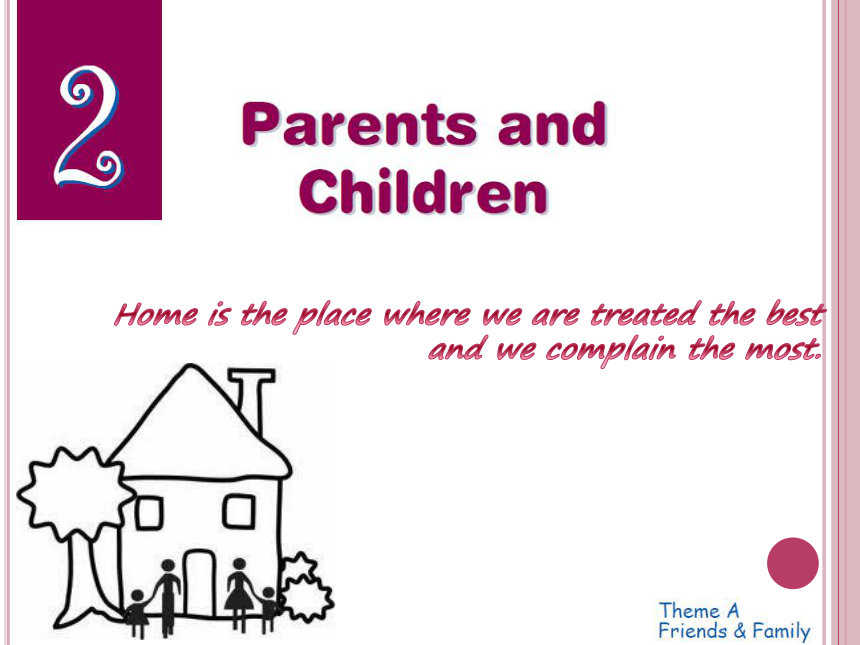
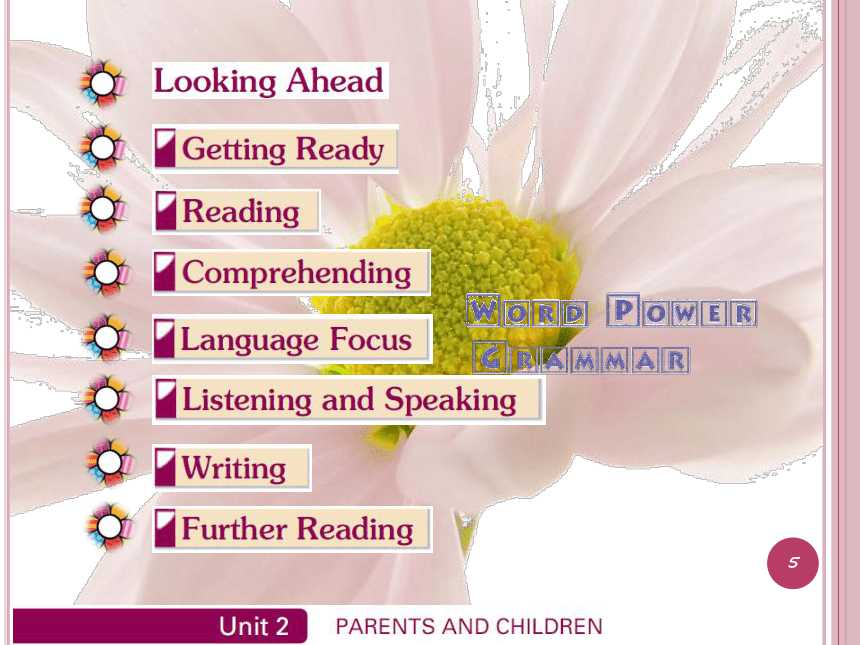
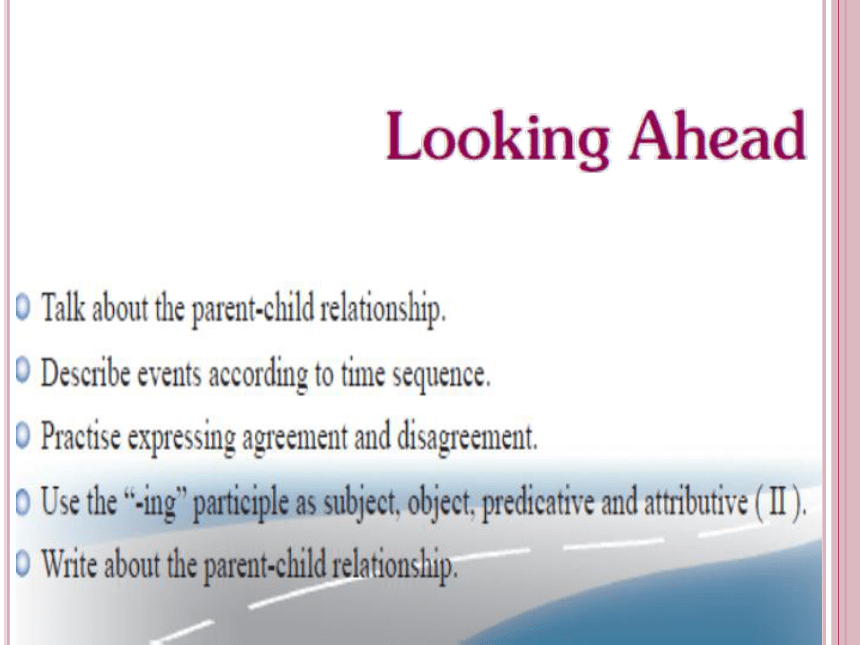
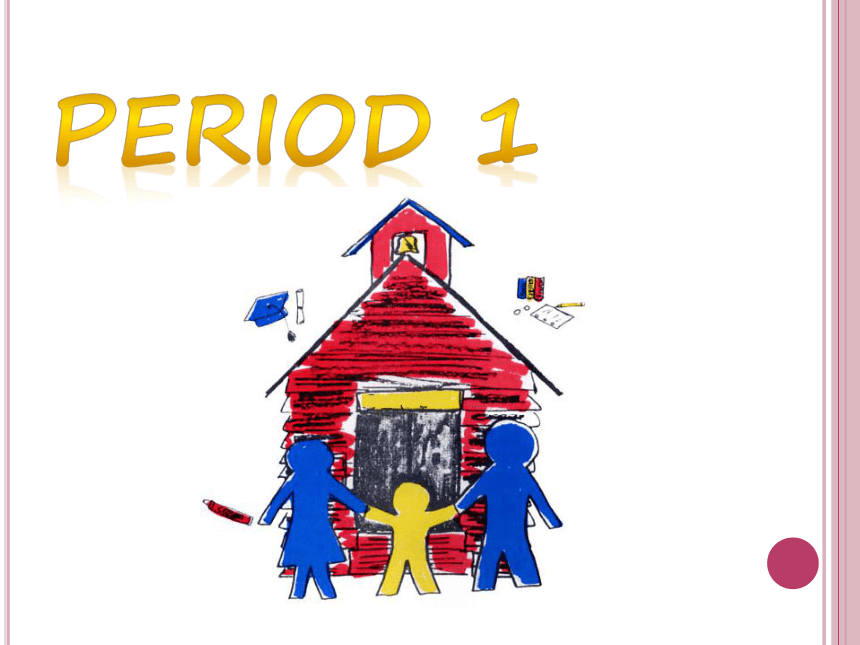

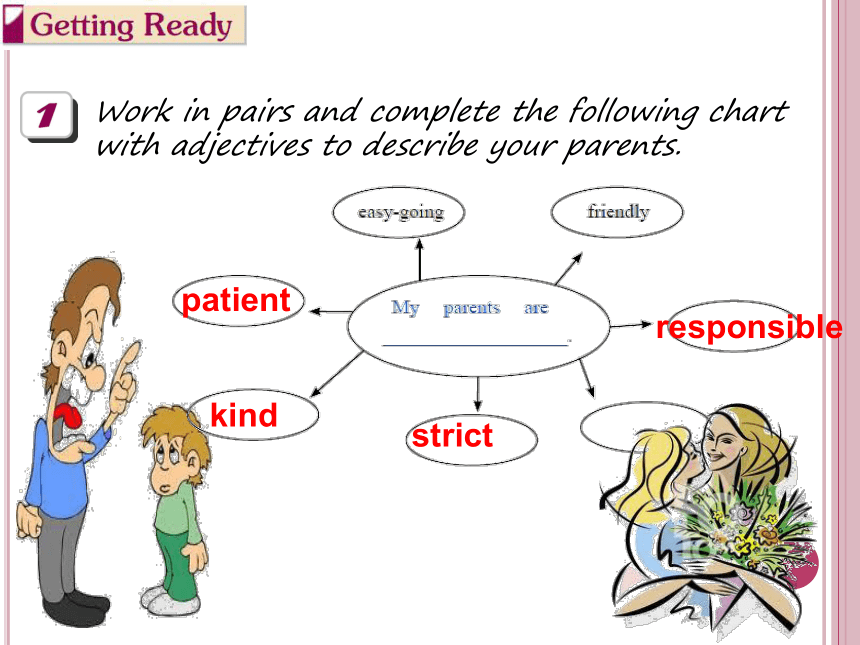
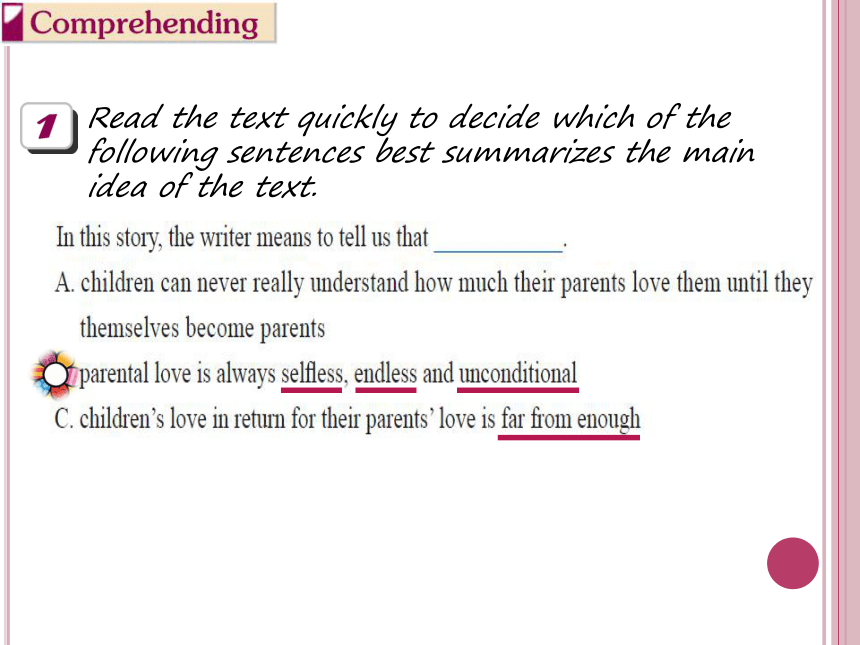


文档简介
(共82张PPT)
*
learned in last unit
Work in pairs and complete the following chart with adjectives to describe your parents.
patient
kind
responsible
strict
Read the text quickly to decide which of the following sentences best summarizes the main idea of the text.
endless adj. 无尽的;无穷的
ending
n. 结局;终点
unconditional adj. 无条件的
conditional
adj. 有条件的
condition
n. 条件
Work with your partner and complete the following passage according to your understanding. Then discuss how you should get along with your parents.
play
leave need
trouble give
Read the story carefully and complete the following table. The first one has been done for you as an example.
grew up, picked and sold all the apples, left happily sad
returned, cut off the branches, left happily excited, lonely and sad
returned, cut the tree trunk, went sailing delighted
returned, sat down on the stump of the tree and rested glad and smiled with tears
Find some key words and expressions in the text to match with the pictures.
house, chop off branches, lonely
tree stump, to have a rest, smile with tears
huge, climb, play with, take a nap, happy
teenager, pick, sell, sad
relax, trunk, boat, sail away, show up
Then arrange the pictures in the correct order according to your understanding of the text.
C→D→A→E→B
choose, pick out & select
1)choose 指在所提供的对象中,凭个人的判断力进行选择,较常用。如:
You are free to choose how you are going to die.
Which one do you choose to take part in the activity
2)pick out指按照个人的喜好或希望进行挑选。比较通俗、随意,多用于有形的东西(人或物)。
Have you picked out your new bike
I picked out a red one from the cherries and tasted it.
3)select 指仔细、认真地选择,有“精选”的含义。
He searched in his drawer and at last selected the cheapest one for me.
Pick sizes, colors and styles of letters, and select pictures to match your text.
But you can pick all my apples and sell them.
shade & shadow
1)shade多与the 连用,作不可数名词。如:
He slept in the shade of the trees.
有时可加不定冠词。如:
What a pleasant shade these trees give us!
2)shadow意为“影子,阴影(可数,不可数)”。如:
The tree is throwing a shadow on the ground.
We are in the shadow of that building.
【注意】谈“树荫”时,两个词都可以用。如:
He slept in the shade of the trees.
And again they watched the wavering shadows of the tree.
He climbed to the top of the tree, ate the apples, took a nap under the shade...
垂死的
die
Discuss with your partner about how children should get along with their parents based on the story above. Then report to the class. Your report may begin like this:
Match each of the words on the left with its explanation on the right.
D
E
G
A
F
B
C
Complete each of the following sentences with the proper form of a word in Task 1.
reply
leaned
shade
shelters
endless
has forecasted
sail
There are many words describing the feelings of the tree and the boy in the text. Work with your partner to find six of them and then make sentences of your own with the words.
excited
happy
delighted
lonely
sad
tired
Study the word formation rules in the table below and then complete each of the following sentences with a word listed in the Example column.
outcome
forehead
turning
foreseen
outgrown
suffering
hearing
outgoing
forecast
shelter
n. 庇护物,遮蔽物
branch
n. 树枝;枝干
trunk
n. 树干
chop off
砍掉;砍下
go sailing
去航行
Read the following dialogue, paying special attention to the coloured parts.
Study each of the following sentences, paying special attention to the coloured parts. Then work with your partner to complete the table.
verb
object
subject
1)把一个动词转换为名词的形式在句中充当主语或宾语,其用法就是动名词。此时,作主语或宾语的动名词具有名词的特征。如:
Standing at the top of the mountain may cause my feeling of being sick.
Middle school students need reading a lot when they are studying English.
2)当充当主语的动名词太长时,常使用形式主语。如:
It’s a waste of money buying such things you don’t really need.
It’s no good trying to persuade him. He is too stubborn.
3)当一些特殊的动词或短语充当谓语时,后面动词宾语必须使用动名词形式。常用的动词及短语有:
admit, appreciate, avoid, consider, delay, dislike, enjoy, escape, excuse, finish, forgive, imagine, include, keep, mention, mind, miss, practise, resist, suggest, put off, can’t help, can’t stand, feel like, give up
4)含有介词to的短语充当谓语时,后面必须使用动名词形式。常见的有:
turn to, be used to, see to, stick to, stand up to, pay attention to, object to, be opposed to, lead to, look forward to, get down to, give way to, be familiar to, find one’s way to, devote oneself to, in addition to, admit to
5)在allow, advise, forbid, permit等谓语动词后面的动词宾语直接使用动名词形式,而当谓语动词后带有名词或代词充当宾语时,则使用不定式形式。
They often advise not smoking in our homes.
They often advise us not to smoke in our homes.
6)当一些特殊的动词充当谓语的时,后面的动词宾语可以跟动名词,也可以跟不定式,而所表达的意义几乎没有差别。如:love, like, prefer, intend等。
7)当一些特殊的动词充当谓语的时候,后面的动词宾语可以跟动名词,也可以跟不定式,而所表达的意义有很大的差别。如:
① forget doing ... 忘记做(已做……② go on doing ...继续做……(同一件事)
forget to do...忘记做(未做)…… go on to do... 继续做……(另一件事)
③ mean to do ...打算做…… ④ regret doing ... 后悔做过……
mean doing... 意味着…… regret to do...抱歉将做……
⑤ remember doing...记得做过…… ⑥ try doing ... 试着做……
remember to do...记住去做…… try to do...努力去做……
⑦ stop doing ... 停止做…… stop to do...停下来去做……
8)动词need, require, want作“需要”讲,后面既可跟动名词也可跟不定式,但它们后面的动名词形式上是主动意义,而实质上表达被动意义。如:
The department store needs rebuilding for a new look.
The department store needs to be rebuilt for a new look.
【注】这些词后面的动名词只能使用主动形式或不定式的正确形式。
Languages require using in a lot of ways. (right)
Languages require being used in a lot of ways. (wrong)
Languages require to be used in a lot of ways.(right)
Students need to use languages in a lot of ways.(right)
9)当一个动词充当表语的成分而具有名词的特征时,也应采用动名词形式来表达。
My job is looking after the old man in this house.
Work in groups and find the difference between the two sentences in each pair. Pay attention to the coloured parts.
Underline the “-ing” participle in each of the following sentences and state its grammatical function, then translate the sentence into Chinese.
Read each of the following sentences carefully and decide whether there is a mistake or not. If yes, mark and correct it.
crying
living
going
to mail
-ing 可以用作:
Teaching was my childhood dream.
Now, my job is teaching.
I love teaching so much.
I always write about my teaching life to my friends.
Discuss with your partner how you express agreement or disagreement, then write down the typical sentence structures.
To express agreement
I agree.
I agree with...
That’s (quite) right/true.
You are right. Sure.
That’s what I think, of course.
I suppose you are right.
To express disagreement
I don’t think...
I may be wrong, but...
Oh, I don’t know/agree.
Yes, but... I’m afraid I can’t agree with you.
Oh, surely not.
No, I don’t think so.
Listen to a conversation and complete the following statements.
Listen to a conversation and complete the following statements.
all the way downtown
that I’d come and help her
just do it herself
Listen to the conversation again and try to fill in the missing information.
you know
Like what
when you two were younger
You always do
What place
the waterfall and the fish pond
if you want to
a fun place
Listen to the conversation carefully and try to find the sentences expressing agreement and disagreement. Then write them down here.
Do you agree with the Chinese saying“子不教,父之过。” ( If a son is not raised well, his father is to blame.)
Discuss with your partner by sharing why you agree or disagree. Try to use the sentence structures in the table below and those you have found in Task 4.
If a son is not raised well, his father is to blame.
Study the picture and answer the following questions.
Study the picture and answer the following questions.
Based on your answers to the questions above, write an open-ended composition with a title of your own. You may follow the following steps.
Check your composition according to the following rules.
Have you ever sent flowers to your dad/mum as a present or got flowers from him/her
If yes, what was the special occasion How did you feel
Answer the questions with your partner and then fill in the following table.
Try to use the information above to write a short paragraph which shows the deep love between you and your dad/mum.
You may begin your paragraph like this:
Read the following words and expressions in the coming article. If they are new to you, ask your partner for help or consult your dictionary.
Read the passage and then fill in the table with the information from the text.
(1)be aware of...知道……;意识到……
Can you show me that you are aware of both sides of the issue
(2)be aware that...知道……;意识到……
So within minutes, millions were aware that he had got the gold medal in the Olympic Games.
As an excited member of the beginners’ chorus group, I was aware of my low status.
用心良苦的父母
Work in groups to discuss and answer the following questions.
Complete each of the following sentences with the proper form of a word or a phrase in the box.
marked
performance
symbolized
is aware of
embarrassed
conflicted
语
言
知
识
单词
活用
词汇 shade shelter branch sail trunk bite root tear
performance beginner chorus aware status lead stage
gaze applaud bunch embarrassment wasteful bakery
occasion well-meaning further graduation mark
emotion conflict career engaged symbolize
victory urge blue hug
认知
词汇 nap chop lean bloom milestone yearly blush footlights misery coffin seesaw shrug daisy
词组 no longer grow up play with have to far away show up
be aware of along with full of gaze over next to feel like
graduate from die of be angry with
表达法 / 句型 a long time ago go by play around chop off go sailing
a sense of cover…with feel an urge to do something…
from behind feel like doing sth. be engaged to
语法 1. 能识别-ing分词的各种功能和用途。
2. 能在-ing分词短语和各种状语从句之间进行互换。
MEMORY CHECK
语
言
技
能
听 1. 了解和熟悉用于表达赞同和不赞同的用语。
2. 能在听的过程中,有目的地捕获所需的信息。
3. 能边听边将缺省的信息补全。
说 1. 能将听力材料中学到的用语用于类似的场景。
2. 能正确灵活地运用表达赞同和不赞同的用语。
读 1. 能通过略读和跳读获取文章的大意和细节信息。
2. 能根据上下文猜测生词的词义。
3. 能识别文章的文体,了解其组织结构和事件的发展顺序。
4. 能熟识用于描述各种情绪的形容词及其用途。
写 1. 运用从课文中抽象出来的主题,结合自己的实际,写一些自己亲身经历的事情。
2. 模仿课文,学习写夹叙夹议的作文。
3. 学会恰当运用过渡词句。
MEMORY CHECK
学习策略 1. 能借助手势和表情等非语言手段提高交际效果。
2. 总结所接触语言材料中出现的语言现象和规律并主动加以运用。
3. 增强借助字典独立解决问题的能力。
情感态度 1. 在学习中,乐于与人合作,愿意主动向他人求助。
2. 能在写作和口语交流中积极使用英语。
文化意识 了解全人类最基本的情感——亲情及其折射出来的文化历史含义。
MEMORY CHECK
*
learned in last unit
Work in pairs and complete the following chart with adjectives to describe your parents.
patient
kind
responsible
strict
Read the text quickly to decide which of the following sentences best summarizes the main idea of the text.
endless adj. 无尽的;无穷的
ending
n. 结局;终点
unconditional adj. 无条件的
conditional
adj. 有条件的
condition
n. 条件
Work with your partner and complete the following passage according to your understanding. Then discuss how you should get along with your parents.
play
leave need
trouble give
Read the story carefully and complete the following table. The first one has been done for you as an example.
grew up, picked and sold all the apples, left happily sad
returned, cut off the branches, left happily excited, lonely and sad
returned, cut the tree trunk, went sailing delighted
returned, sat down on the stump of the tree and rested glad and smiled with tears
Find some key words and expressions in the text to match with the pictures.
house, chop off branches, lonely
tree stump, to have a rest, smile with tears
huge, climb, play with, take a nap, happy
teenager, pick, sell, sad
relax, trunk, boat, sail away, show up
Then arrange the pictures in the correct order according to your understanding of the text.
C→D→A→E→B
choose, pick out & select
1)choose 指在所提供的对象中,凭个人的判断力进行选择,较常用。如:
You are free to choose how you are going to die.
Which one do you choose to take part in the activity
2)pick out指按照个人的喜好或希望进行挑选。比较通俗、随意,多用于有形的东西(人或物)。
Have you picked out your new bike
I picked out a red one from the cherries and tasted it.
3)select 指仔细、认真地选择,有“精选”的含义。
He searched in his drawer and at last selected the cheapest one for me.
Pick sizes, colors and styles of letters, and select pictures to match your text.
But you can pick all my apples and sell them.
shade & shadow
1)shade多与the 连用,作不可数名词。如:
He slept in the shade of the trees.
有时可加不定冠词。如:
What a pleasant shade these trees give us!
2)shadow意为“影子,阴影(可数,不可数)”。如:
The tree is throwing a shadow on the ground.
We are in the shadow of that building.
【注意】谈“树荫”时,两个词都可以用。如:
He slept in the shade of the trees.
And again they watched the wavering shadows of the tree.
He climbed to the top of the tree, ate the apples, took a nap under the shade...
垂死的
die
Discuss with your partner about how children should get along with their parents based on the story above. Then report to the class. Your report may begin like this:
Match each of the words on the left with its explanation on the right.
D
E
G
A
F
B
C
Complete each of the following sentences with the proper form of a word in Task 1.
reply
leaned
shade
shelters
endless
has forecasted
sail
There are many words describing the feelings of the tree and the boy in the text. Work with your partner to find six of them and then make sentences of your own with the words.
excited
happy
delighted
lonely
sad
tired
Study the word formation rules in the table below and then complete each of the following sentences with a word listed in the Example column.
outcome
forehead
turning
foreseen
outgrown
suffering
hearing
outgoing
forecast
shelter
n. 庇护物,遮蔽物
branch
n. 树枝;枝干
trunk
n. 树干
chop off
砍掉;砍下
go sailing
去航行
Read the following dialogue, paying special attention to the coloured parts.
Study each of the following sentences, paying special attention to the coloured parts. Then work with your partner to complete the table.
verb
object
subject
1)把一个动词转换为名词的形式在句中充当主语或宾语,其用法就是动名词。此时,作主语或宾语的动名词具有名词的特征。如:
Standing at the top of the mountain may cause my feeling of being sick.
Middle school students need reading a lot when they are studying English.
2)当充当主语的动名词太长时,常使用形式主语。如:
It’s a waste of money buying such things you don’t really need.
It’s no good trying to persuade him. He is too stubborn.
3)当一些特殊的动词或短语充当谓语时,后面动词宾语必须使用动名词形式。常用的动词及短语有:
admit, appreciate, avoid, consider, delay, dislike, enjoy, escape, excuse, finish, forgive, imagine, include, keep, mention, mind, miss, practise, resist, suggest, put off, can’t help, can’t stand, feel like, give up
4)含有介词to的短语充当谓语时,后面必须使用动名词形式。常见的有:
turn to, be used to, see to, stick to, stand up to, pay attention to, object to, be opposed to, lead to, look forward to, get down to, give way to, be familiar to, find one’s way to, devote oneself to, in addition to, admit to
5)在allow, advise, forbid, permit等谓语动词后面的动词宾语直接使用动名词形式,而当谓语动词后带有名词或代词充当宾语时,则使用不定式形式。
They often advise not smoking in our homes.
They often advise us not to smoke in our homes.
6)当一些特殊的动词充当谓语的时,后面的动词宾语可以跟动名词,也可以跟不定式,而所表达的意义几乎没有差别。如:love, like, prefer, intend等。
7)当一些特殊的动词充当谓语的时候,后面的动词宾语可以跟动名词,也可以跟不定式,而所表达的意义有很大的差别。如:
① forget doing ... 忘记做(已做……② go on doing ...继续做……(同一件事)
forget to do...忘记做(未做)…… go on to do... 继续做……(另一件事)
③ mean to do ...打算做…… ④ regret doing ... 后悔做过……
mean doing... 意味着…… regret to do...抱歉将做……
⑤ remember doing...记得做过…… ⑥ try doing ... 试着做……
remember to do...记住去做…… try to do...努力去做……
⑦ stop doing ... 停止做…… stop to do...停下来去做……
8)动词need, require, want作“需要”讲,后面既可跟动名词也可跟不定式,但它们后面的动名词形式上是主动意义,而实质上表达被动意义。如:
The department store needs rebuilding for a new look.
The department store needs to be rebuilt for a new look.
【注】这些词后面的动名词只能使用主动形式或不定式的正确形式。
Languages require using in a lot of ways. (right)
Languages require being used in a lot of ways. (wrong)
Languages require to be used in a lot of ways.(right)
Students need to use languages in a lot of ways.(right)
9)当一个动词充当表语的成分而具有名词的特征时,也应采用动名词形式来表达。
My job is looking after the old man in this house.
Work in groups and find the difference between the two sentences in each pair. Pay attention to the coloured parts.
Underline the “-ing” participle in each of the following sentences and state its grammatical function, then translate the sentence into Chinese.
Read each of the following sentences carefully and decide whether there is a mistake or not. If yes, mark and correct it.
crying
living
going
to mail
-ing 可以用作:
Teaching was my childhood dream.
Now, my job is teaching.
I love teaching so much.
I always write about my teaching life to my friends.
Discuss with your partner how you express agreement or disagreement, then write down the typical sentence structures.
To express agreement
I agree.
I agree with...
That’s (quite) right/true.
You are right. Sure.
That’s what I think, of course.
I suppose you are right.
To express disagreement
I don’t think...
I may be wrong, but...
Oh, I don’t know/agree.
Yes, but... I’m afraid I can’t agree with you.
Oh, surely not.
No, I don’t think so.
Listen to a conversation and complete the following statements.
Listen to a conversation and complete the following statements.
all the way downtown
that I’d come and help her
just do it herself
Listen to the conversation again and try to fill in the missing information.
you know
Like what
when you two were younger
You always do
What place
the waterfall and the fish pond
if you want to
a fun place
Listen to the conversation carefully and try to find the sentences expressing agreement and disagreement. Then write them down here.
Do you agree with the Chinese saying“子不教,父之过。” ( If a son is not raised well, his father is to blame.)
Discuss with your partner by sharing why you agree or disagree. Try to use the sentence structures in the table below and those you have found in Task 4.
If a son is not raised well, his father is to blame.
Study the picture and answer the following questions.
Study the picture and answer the following questions.
Based on your answers to the questions above, write an open-ended composition with a title of your own. You may follow the following steps.
Check your composition according to the following rules.
Have you ever sent flowers to your dad/mum as a present or got flowers from him/her
If yes, what was the special occasion How did you feel
Answer the questions with your partner and then fill in the following table.
Try to use the information above to write a short paragraph which shows the deep love between you and your dad/mum.
You may begin your paragraph like this:
Read the following words and expressions in the coming article. If they are new to you, ask your partner for help or consult your dictionary.
Read the passage and then fill in the table with the information from the text.
(1)be aware of...知道……;意识到……
Can you show me that you are aware of both sides of the issue
(2)be aware that...知道……;意识到……
So within minutes, millions were aware that he had got the gold medal in the Olympic Games.
As an excited member of the beginners’ chorus group, I was aware of my low status.
用心良苦的父母
Work in groups to discuss and answer the following questions.
Complete each of the following sentences with the proper form of a word or a phrase in the box.
marked
performance
symbolized
is aware of
embarrassed
conflicted
语
言
知
识
单词
活用
词汇 shade shelter branch sail trunk bite root tear
performance beginner chorus aware status lead stage
gaze applaud bunch embarrassment wasteful bakery
occasion well-meaning further graduation mark
emotion conflict career engaged symbolize
victory urge blue hug
认知
词汇 nap chop lean bloom milestone yearly blush footlights misery coffin seesaw shrug daisy
词组 no longer grow up play with have to far away show up
be aware of along with full of gaze over next to feel like
graduate from die of be angry with
表达法 / 句型 a long time ago go by play around chop off go sailing
a sense of cover…with feel an urge to do something…
from behind feel like doing sth. be engaged to
语法 1. 能识别-ing分词的各种功能和用途。
2. 能在-ing分词短语和各种状语从句之间进行互换。
MEMORY CHECK
语
言
技
能
听 1. 了解和熟悉用于表达赞同和不赞同的用语。
2. 能在听的过程中,有目的地捕获所需的信息。
3. 能边听边将缺省的信息补全。
说 1. 能将听力材料中学到的用语用于类似的场景。
2. 能正确灵活地运用表达赞同和不赞同的用语。
读 1. 能通过略读和跳读获取文章的大意和细节信息。
2. 能根据上下文猜测生词的词义。
3. 能识别文章的文体,了解其组织结构和事件的发展顺序。
4. 能熟识用于描述各种情绪的形容词及其用途。
写 1. 运用从课文中抽象出来的主题,结合自己的实际,写一些自己亲身经历的事情。
2. 模仿课文,学习写夹叙夹议的作文。
3. 学会恰当运用过渡词句。
MEMORY CHECK
学习策略 1. 能借助手势和表情等非语言手段提高交际效果。
2. 总结所接触语言材料中出现的语言现象和规律并主动加以运用。
3. 增强借助字典独立解决问题的能力。
情感态度 1. 在学习中,乐于与人合作,愿意主动向他人求助。
2. 能在写作和口语交流中积极使用英语。
文化意识 了解全人类最基本的情感——亲情及其折射出来的文化历史含义。
MEMORY CHECK
同课章节目录
- 3
- Unit 1 Friends and Friendship
- Unit 2 Between Parents and Us
- Unit 3 Motherly Love
- Unit 4 Dreams
- Unit 5 Wishes and Ambitions
- Unit 6 Perseverance
- Unit 7 Art
- Unit 8 Drama
- Unit 9 Poetry
- 4
- Unit 1 Project Hope
- Unit 2 Three Gorges
- Unit 3 Countries and Regions
- Unit 4 Plants
- Unit 5 Animals
- Unit 6 Man and Pets
- Unit 7 Neighborhood
- Unit 8 Workplace
- Unit 9 Living Today
